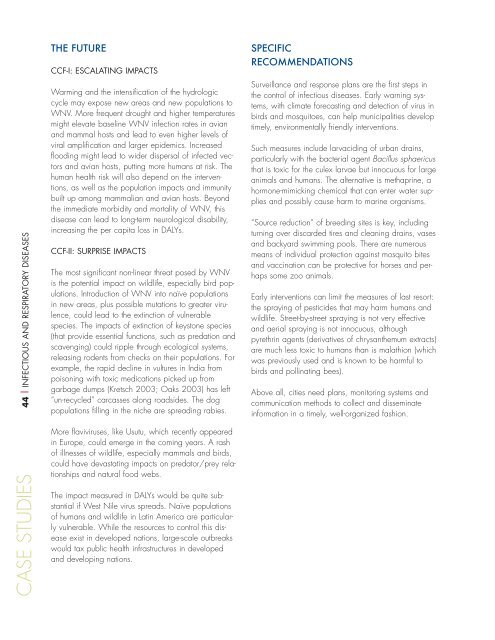Climate change futures: health, ecological and economic dimensions
Climate change futures: health, ecological and economic dimensions
Climate change futures: health, ecological and economic dimensions
Create successful ePaper yourself
Turn your PDF publications into a flip-book with our unique Google optimized e-Paper software.
44 | INFECTIOUS AND RESPIRATORY DISEASES<br />
CASE STUDIES<br />
THE FUTURE<br />
CCF-I: ESCALATING IMPACTS<br />
Warming <strong>and</strong> the intensification of the hydrologic<br />
cycle may expose new areas <strong>and</strong> new populations to<br />
WNV. More frequent drought <strong>and</strong> higher temperatures<br />
might elevate baseline WNV infection rates in avian<br />
<strong>and</strong> mammal hosts <strong>and</strong> lead to even higher levels of<br />
viral amplification <strong>and</strong> larger epidemics. Increased<br />
flooding might lead to wider dispersal of infected vectors<br />
<strong>and</strong> avian hosts, putting more humans at risk. The<br />
human <strong>health</strong> risk will also depend on the interventions,<br />
as well as the population impacts <strong>and</strong> immunity<br />
built up among mammalian <strong>and</strong> avian hosts. Beyond<br />
the immediate morbidity <strong>and</strong> mortality of WNV, this<br />
disease can lead to long-term neurological disability,<br />
increasing the per capita loss in DALYs.<br />
CCF-II: SURPRISE IMPACTS<br />
The most significant non-linear threat posed by WNV<br />
is the potential impact on wildlife, especially bird populations.<br />
Introduction of WNV into naïve populations<br />
in new areas, plus possible mutations to greater virulence,<br />
could lead to the extinction of vulnerable<br />
species. The impacts of extinction of keystone species<br />
(that provide essential functions, such as predation <strong>and</strong><br />
scavenging) could ripple through <strong>ecological</strong> systems,<br />
releasing rodents from checks on their populations. For<br />
example, the rapid decline in vultures in India from<br />
poisoning with toxic medications picked up from<br />
garbage dumps (Kretsch 2003; Oaks 2003) has left<br />
“un-recycled” carcasses along roadsides. The dog<br />
populations filling in the niche are spreading rabies.<br />
More flaviviruses, like Usutu, which recently appeared<br />
in Europe, could emerge in the coming years. A rash<br />
of illnesses of wildlife, especially mammals <strong>and</strong> birds,<br />
could have devastating impacts on predator/prey relationships<br />
<strong>and</strong> natural food webs.<br />
The impact measured in DALYs would be quite substantial<br />
if West Nile virus spreads. Naïve populations<br />
of humans <strong>and</strong> wildlife in Latin America are particularly<br />
vulnerable. While the resources to control this disease<br />
exist in developed nations, large-scale outbreaks<br />
would tax public <strong>health</strong> infrastructures in developed<br />
<strong>and</strong> developing nations.<br />
SPECIFIC<br />
RECOMMENDATIONS<br />
Surveillance <strong>and</strong> response plans are the first steps in<br />
the control of infectious diseases. Early warning systems,<br />
with climate forecasting <strong>and</strong> detection of virus in<br />
birds <strong>and</strong> mosquitoes, can help municipalities develop<br />
timely, environmentally friendly interventions.<br />
Such measures include larvaciding of urban drains,<br />
particularly with the bacterial agent Bacillus sphaericus<br />
that is toxic for the culex larvae but innocuous for large<br />
animals <strong>and</strong> humans. The alternative is methaprine, a<br />
hormone-mimicking chemical that can enter water supplies<br />
<strong>and</strong> possibly cause harm to marine organisms.<br />
“Source reduction” of breeding sites is key, including<br />
turning over discarded tires <strong>and</strong> cleaning drains, vases<br />
<strong>and</strong> backyard swimming pools. There are numerous<br />
means of individual protection against mosquito bites<br />
<strong>and</strong> vaccination can be protective for horses <strong>and</strong> perhaps<br />
some zoo animals.<br />
Early interventions can limit the measures of last resort:<br />
the spraying of pesticides that may harm humans <strong>and</strong><br />
wildlife. Street-by-street spraying is not very effective<br />
<strong>and</strong> aerial spraying is not innocuous, although<br />
pyrethrin agents (derivatives of chrysanthemum extracts)<br />
are much less toxic to humans than is malathion (which<br />
was previously used <strong>and</strong> is known to be harmful to<br />
birds <strong>and</strong> pollinating bees).<br />
Above all, cities need plans, monitoring systems <strong>and</strong><br />
communication methods to collect <strong>and</strong> disseminate<br />
information in a timely, well-organized fashion.

















